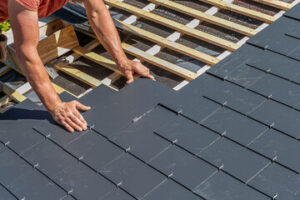Water Damage Restoration Salt Lake City is a complex process that should be left to professionals. Look for a company with industry-leading certifications and years of experience.
Standing water in your home is more than a nuisance: it can breed mold and bacteria that pose a health risk.

A professional assessment of your home’s water damage can save you time, money, and headaches. It’s also important for documenting damage to help you get reimbursed from insurance companies.
Removing Damaged Materials
Before any restoration work can begin, a water damage specialist will first need to remove any standing water. This is usually done with large pumps that can clear out gallons of water in one go. Then, any damaged materials that can’t be saved are removed from the area to be disposed of later. This will include carpeting, wood flooring, insulation and any other porous materials.
When it comes to removing damaged materials, the process is different depending on the type of water damage that has occurred. The professionals will determine which category the water damage fits into. This will help them know which materials to use, if any, during the cleanup process. Clean water, such as that from a rainstorm or leaky pipe, is class one water damage. Gray water, such as that which is leaked from appliances like washing machines or toilets, is class two water damage. This type of water contains chemicals and other contaminants that can cause illness if ingested. Black water, such as that which is caused by sewage backup or flooding from nearby rivers, is classified as category three water damage. This type of water is highly dangerous and requires special safety precautions to be handled.
Once all of the excess water has been removed from the area, the drying and dehumidification processes can begin. This is done with the help of commercial-grade air movers and dehumidifiers, along with opening windows to increase circulation. It may take a while for the space to dry out completely, especially if it is very large or has sustained heavy water damage.
During this time, it is important to unplug all electrical items in the affected area. This is because electrical shocks can occur if you continue to use electronics in the presence of water. It is also helpful to keep records of any purchases that have been made for items that were destroyed by the water damage, as these will be useful when filing an insurance claim. It is also recommended to save receipts and invoices from any professional services that have been provided so that you can be reimbursed by your insurance company.
Disinfecting the Area
Once the water damage restoration process has begun, it is important to disinfect the area. This includes wood floors, carpets, rugs, furniture and other contents. Even if they look unaffected, they may contain harmful bacteria and other microorganisms. These organisms can cause serious health problems, so they need to be sanitized thoroughly before any restoration work is done. This will also help prevent mold from growing in the affected area.
It is also important to make sure the affected area is completely dry before starting any restoration work. This can be done by using fans and dehumidifiers to circulate air in the affected space. It is also a good idea to turn off any electrical outlets in the area and handle any appliances that have been wet with caution. This will protect against short circuits and fires caused by too much moisture in the area.
The first step in this process is to determine the source of the flooding and how severe the damage is. This will allow a professional to assess the situation and develop an appropriate restoration plan. They will look for signs of mold and other contaminants that could affect your health. In most cases, they will use a moisture meter to measure the level of humidity in the affected area.
After the initial assessment, the professionals will remove any materials that have been damaged by the water. This will include drywall, carpeting and flooring as necessary. In some cases, this may involve removing the entire section of drywall and replacing it with new material. The professionals will then tape and mud the seams to ensure a clean finish.
It is also a good idea to remove any items that are not salvageable. This can include stuffed animals, furniture and other items that are made from a fabric. These items can be cleaned in the washing machine, but they should be sanitized and disinfected before being put back into the affected space. The contaminated materials should be bagged and tagged appropriately for disposal, as they could contain harmful bacteria.
Drying Out the Area
Once the water has been extracted and the affected materials removed, it’s time to begin drying out the space. This involves more than just opening windows, although that is often the first step. It requires circulating air, using dehumidifiers, and checking every nook and cranny to make sure the space is fully dry.
This step is especially important if there are any structural components that may have been affected by the incident. Moisture trapped in these areas can lead to warping, rot, and mold. This is why it’s important to have a professional perform the restoration process.
Stagnant water can also create ideal breeding grounds for bacteria, mold, and other harmful organisms. Once these organisms are allowed to grow and spread, they can cause health issues in humans and animals. This can include everything from mildew and fungal growth to diseases like bacterial pneumonia.
After the area has been dried, it will be disinfected and sanitized to remove any remaining bacteria. This is usually done with commercial sanitizing solutions or steam cleaning. The space will then be aired out and any remaining moisture will be removed with commercial dehumidifiers.
The sanitary disinfection and drying out process can take quite some time, but it’s critical to get the job done right. This can help ensure that the structure is safe to return to use, that it’s free of any dangerous bacteria or other organisms, and that any damage caused by the incident will be restored properly.
It’s also possible that certain building materials will need to be removed and replaced. This can include things like drywall down to the studs, carpeting, and carpet padding. This is typically done before the drying out process begins, as it can lead to a more efficient overall drying process.
Water damage restoration is a big job that can be very complicated. Having professionals like COIT on your side can make the process go much more smoothly and quickly. Contact us today to learn more about how we can restore your property to its original condition. We have over 70 years of experience in the industry, so you can trust that we’ll get the job done right.
Restoring Structural Components
A home or business will need water damage restoration if it is ever the victim of a disaster like a flood, a burst pipe or even just a regular leak. Water damage is not something that can be ignored and should always be repaired as soon as possible. If left untreated, wooden structures like drywall or cabinets will rot, and metal items will rust.
A professional assessment should be completed to determine the extent of the damage and the steps that need to be taken to restore the structure to its pre-water state. During the initial stages of the water damage restoration process, it’s important to extract as much moisture as possible from affected areas. This can be done using a submersible pump, wet/dry vacuum or simply mops and buckets. The next step is to disinfect the area and deodorize it. This will eliminate any mold or mildew that may have formed as a result of the water damage.
Once the water and any contaminants have been removed and the area has been thoroughly cleaned, it’s time to start restoring the structural components of the building. This can be difficult and will often require the help of a licensed plumber. In some cases, it’s necessary to replace materials such as flooring, drywall or cabinetry. This can be expensive but is necessary to prevent further damage to the structure.
It is also important to inspect electrical and HVAC systems before reactivating them. This is because water exposure can lead to electrical shorts and heating, ventilation and air conditioning problems. If these systems are not inspected and properly restored, they could pose a safety risk to people and pets.
Depending on the severity of the water damage and the type of material affected, it’s possible that some of the damaged parts of the property can be salvaged. This can include furniture, rugs and other items that were soaked or completely submerged in the water. However, if these materials are too damaged to be repaired or if they were exposed to sewage, then they will need to be replaced.






